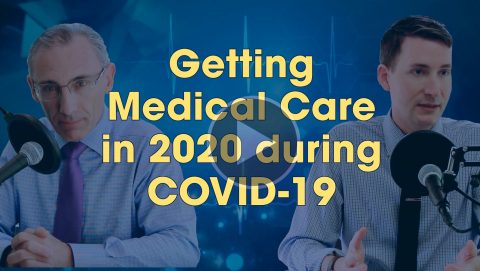Podcast: Getting Medical Care in 2020 during COVID-19

Show-Notes from our fourth podcast:
Getting Medical Care in 2020 during COVID-19, from our new series “Coronavirus: Science and Prevention”
Watch the episode on YouTube and
subscribe to our podcast series on iTunes, Google Podcasts, and Spotify.
Social isolation is great for home, but how do we continue to get medical care as patients and provide medical care as physicians and not fall victim to COVID-19?
The way medicine is practiced has changed radically in the last 6 weeks.
- Visits have shifted towards telemedicine
- Standards of surgical and procedural medicine continue to change
How has our practice, which handles skin cancer treatment and dermatology changed since the start of COVID-19?
Medicare and PPO have relaxed requirements for using and reimbursing telemedicine visits
- Platforms include, but are not limited to, Doxy, Dermio, and Zoom.
How Do We Use Telemedicine?
Cons
- Use of technology can be difficult for elderly patients.
- Lack of ability to do an excellent physical exam
- The video image quality and patient ability
- Store & Forward: patients send photos prior to meeting for physician to review before telemedicine visit
Pros
- Convience for patients
- Safety of Social Distancing
- Patients in outlying areas can be seen by a specialist more easily
- Initial consultations completed through telelmedicine
Adaptations with In-Person Visits
Biopsies, excisions, Mohs surgery, and reconstruction visits can be made shorter through an initial telemedicine consultation. This thereby decreases exposure time of patients, staff, and physicians.
Q&A with SCARS Center Dermatologist, Dr. Mark Juhl
Q) What if a patient is certain about a suspicious lesion? Could you schedule Mohs without having done a biopsy?
A) Traditionally, we would biopsy during the evaluation visit. With the current circumstances, what we can do is take a frozen section of visible tumor the day of your planned Mohs surgery, process it quickly and look at it under the microscope and make the diagnosis prior to beginning Mohs surgery.
Q) Some patients are nervous about coming into doctors offices for treatment. Could you talk about topical treatment for skin cancers?
A) This can be used for superficial skin cancers. When it only invades the topical surface (epidermis), topical chemotherapy creams can be used to treat it for several months and delay an in person visit.
Q) Which treatments can be done entirely through telehealth?
A) The common ones are acne and psorasis. Acne is very common and you don’t need lab work done for diagnosis, as well as psorasis. These can both be easily treated through telederm as long as you aren’t prescribing the more intensive medication like acutane for acne or injections for psorasis.
Q) Which skin lesions can you identify through telehealth?
A) You can diagnose many benign lesions without having to come into the office.
Our prediction? Telemedicine is here to stay.
What We are Doing at SCARS Center
We have drastically reduced the number of in-person visits to our clinic and surgery center and are taking extreme precautions with anyone entering our facility.
All persons entering the clinic, including staff and physicians, are screened for the symptoms of COVID 19. Their temperature is taken and they are asked to sanitize their hands.
All staff are required to wear a mask, which is provided to them. Additionally, all patients are given a mask that they must wear.
Only the patients are allowed in exam rooms so as to maintain as much social distance as possible.
We Fight the Virus on Two Fronts
1.) Fomites
2.) Aerosolization
- Viruses can aerosolize and become airborne in the plume smoke during electrocautery, which is used to control bleeding during a procedure.
- All staff present in the procedure must wear an N-95 mask
- Eyes must be fully enclosed (CAPR alternative -controlled air purifying respir)
- At SCARS Center, we have implemented two air suctioning devices to collect the smoke plumes during this process.
In the surgery center more extreme precautions are being taken.
- All patients with higher risk surgery are tested for COVID with a NP swab. If the test is negative, their treatment is done 4 days after. The patient signs an isolation contract to stay at home until the day of their procedure.
- They are isolated in the same room for the duration of their procedure. A designated care team is assigned to that patient and only they can enter the room.
- Specialized draping is now being used that will isolate the mucous membranes, and airway.
- The surgery center has better ventilation and a higher standard of precautions.
Cases We Cannot Do:
We are not performing any cosmetic procedures. Once there is a two week period of decreasing cases per day, then Phase 1 to recovery guildelines can be instituted.
